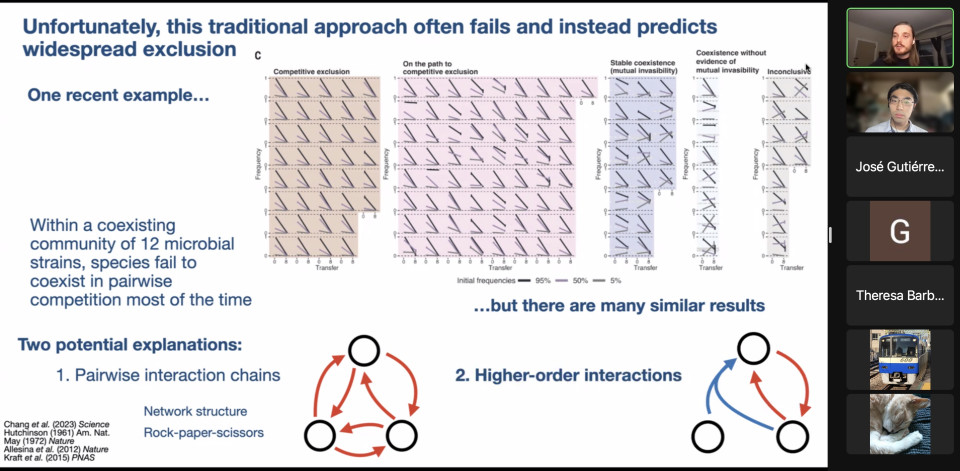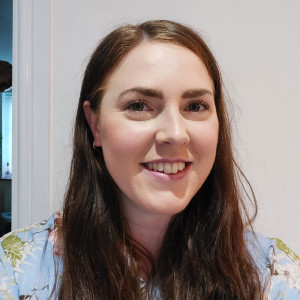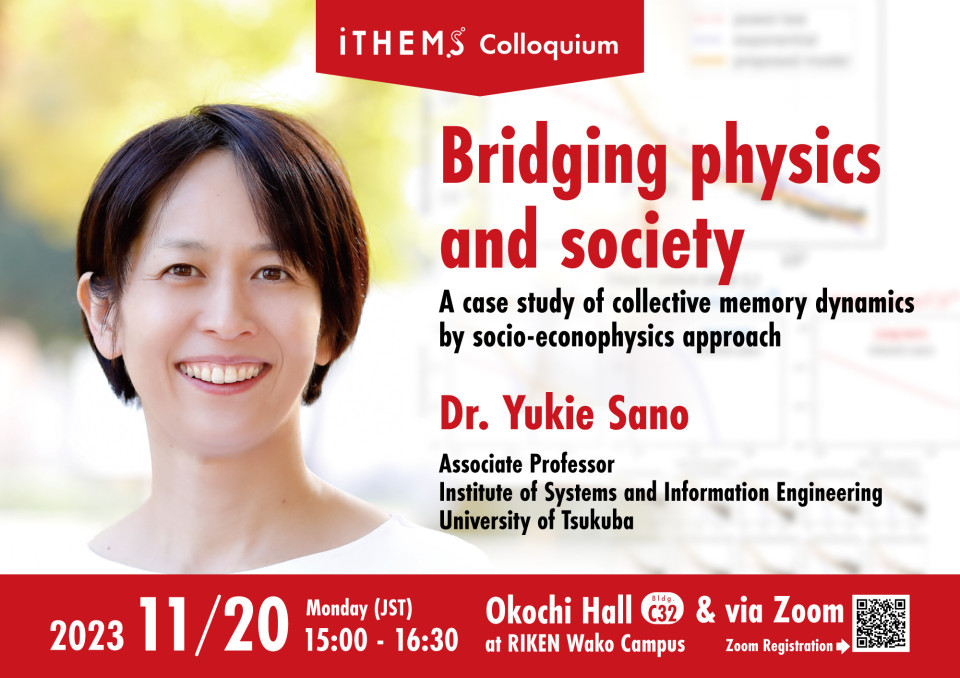Volume 273
Back to Newsletter List
Seminar Report
iTHEMS Biology Seminar by Theo Gibbs on October 10, 2023
2023-10-13
A central assumption in most ecological models is that the interactions in a community operate only between pairs of species. However, two species may interactively affect the growth of a focal species. Although interactions among three or more species, called higher-order interactions, have the potential to modify our theoretical understanding of coexistence, ecologists lack clear expectations for how these interactions shape community structure. In this talk, Theo Gibbs (Ph. D, Princeton Univ.) will analyze two different sets of assumptions for how higher-order interactions impact the dynamics of competing species and show that they lead to differing outcomes. When higher-order interactions are sampled from unconstrained probability distributions, they are unlikely to generate widespread coexistence. In fact, using an analytical technique from statistical physics, he will show many — though not all — of the qualitative rules derived for pairwise interactions still apply to the higher-order case. Higher-order interactions that have specific relationships with the underlying pairwise interactions, however, can stabilize coexistence in diverse communities. He will conclude by briefly discussing ongoing experimental work that seeks to determine whether or not the dynamics of annual plant communities are structured by higher-order interactions.
Reported by Keiichi Morita
Do higher-order interactions promote coexistence in diverse ecological communities?
October 10 (Tue) 10:00 - 11:00, 2023
Upcoming Events
Seminar
iTHEMS Math Seminar
A cluster algebra structure in the quantum cohomology ring of a quiver variety
October 24 (Tue) 10:00 - 11:30, 2023
Yingchun Zhang (Postdoctoral Researcher, Institute for Advanced Study in Mathematics, Zhejiang University, China)
The Gromov-Witten theory of a quiver variety is expected to be preserved by quiver mutation according to Seiberg duality, which has been proved to be true for A-type and star-shaped quivers. Cluster algebra can be constructed for a given quiver via quiver mutation. The two subjects Gromov-Witten and cluster algebra seem to differ a lot. Howerver, when we move to the quantum cohomology ring of a quiver variety, Benini-Park-Zhao’s work “indicates” that there should be a cluster algebra structure in the quantum cohomology ring of the quiver variety. In this talk, I will introduce our recent work about the construction of such a cluster algebra structure in the quantum cohomology of a quiver variety. In particular, we will give a proof of the construction for A-type cluster algebra in quantum cohomology of a flag variety.
This is a joint work with Weiqiang He.
Venue: Seminar Room #359, 3F Main Research Building, RIKEN
Event Official Language: English
Seminar
iTHEMS Theoretical Physics Seminar
Topological Aspect of Adsorption Site Selectivity on Metal Surfaces
October 24 (Tue) 13:30 - 15:00, 2023
Yuta Tsuji (Associate Professor, Faculty of Engineering Sciences, Kyushu University)
In this talk, the presenter will discuss which adsorption structure is preferred in the adsorption of atoms and molecules on metal surfaces based on the topology of the adsorption structures. The method of moments is used to analyze the electronic density of states of the surface. The third-order moment, which characterizes the skewness of the distribution of the electronic density of states, is related to the topology of the triangles at the adsorption interface. By further relating this to the change in energy of the system with the change in electron occupancy of the states, it is shown that it is possible to discuss the relationship between the type of metal and the topological features of the energetically stable adsorption structure.
Venue: Seminar Room #359, 3F Main Research Building, RIKEN / via Zoom
Event Official Language: English
Seminar
DMWG Seminar
Searching for dark neutrinos through exotic Higgs decays at the ILC
October 24 (Tue) 16:30 - 17:30, 2023
Simon Thor (Ph.D. Student, KTH Royal Institute of Technology, Sweden)
In this study we investigate the feasibility of detecting heavy dark neutrinos ($N_d$) through exotic Higgs decays at the proposed International Linear Collider (ILC), specifically in the channel of $e^+ e^- \to qq~ H$ with $H\to \nu N_d \to \nu~lW \to \nu l~qq$. Analyses based on full detector simulations of the ILD are performed at the center-of-mass energy of 250 GeV for two different beam polarization schemes with a total integrated luminosity of 2 $\mathrm{ab}^{-1}$. A range of dark neutrino masses between the $Z$ boson and Higgs boson masses are studied. The $2\sigma$ significance reach for the joint branching ratio of $BR(H\to\nu N_d)\cdot BR(N_d\to lW)$ is about 0.1\%, nearly independent of the dark neutrino masses, while the $5\sigma$ discovery is possible at a branching ratio of $0.3\%$. Interpreting these results in terms of constraints on the mixing parameters $|\varepsilon_{id}|^2$ between SM neutrinos and the dark neutrino, it is expected to have a factor of 10 improvement from current constraints.
Reference
- Simon Thor, Masaya Ishino, Junping Tian, Searching for dark neutrinos through exotic Higgs decays at the ILC, arXiv: 2309.11254
Venue: via Zoom
Event Official Language: English
Seminar
iTHEMS Biology Seminar
Mathematical modelling of the host response to inhalational anthrax across different scales
October 31 (Tue) 16:00 - 17:00, 2023
Bevelynn Williams (Postdoctoral Fellow, School of Mathematics, University of Leeds, UK)
Inhalational anthrax, caused by the bacterium Bacillus anthracis, is a disease with very high fatality rates. Due to the significant risk posed if the bacterium was to be intentionally used as a bioweapon, it is important to be able to defend against such an attack and to make optimal decisions about treatment strategies. Mechanistic mathematical models can help to quantify and improve understanding of the underlying mechanisms of the infection. In this talk, I will present a multi-scale mathematical model for the infection dynamics of inhalational anthrax. This approach involves constructing individual models for the intracellular, within-host, and population-level infection dynamics, to define key quantities characterising infection at each level, which can be used to link dynamics across scales. I will begin by introducing a model for the intracellular infection dynamics of B. anthracis, which describes the interaction between B. anthracis spores and host cells. The model can be used to predict the distribution of outcomes from this host-pathogen interaction. For example, it can be used to estimate the number of bacteria released upon rupture of an infected phagocyte, as well as the timing of phagocyte rupture and bacterial release. Next, I will show how these key outputs can be used to connect the intracellular model to a model of the infection at the within-host scale. The within-host model aims to provide an overall understanding of the early progression of the infection, and is parametrised with infection data from studies of rabbits and guinea pigs. Furthermore, this model allows the probability of infection and the time to infection to be calculated. Building a model that offers a realistic mechanistic description of these different animal responses to the inhalation of B. anthracis spores is an important step towards eventually extrapolating the model to describe the dynamics of human infection. This would enable predictions of how many individuals would become infected in different exposure scenarios and also on what timescale this would occur.
Venue: via Zoom / Hybrid Format (3F #359 and Zoom), Main Research Building, RIKEN Wako Campus
Event Official Language: English
Seminar
iTHEMS Theoretical Physics Seminar
Compact Star Solutions Beyond General Relativity
November 7 (Tue) 13:30 - 15:00, 2023
Kota Numajiri (Ph.D. Student, Graduate School of Science, Nagoya University)
The neutron star solutions have been gathering attention. Their high compactness enables us to observationally access the information about extreme regimes of hadron physics. On the other hand, their strong gravity features bring up another possibility, gravity beyond general relativity (GR).
Although GR has been a great success until now, the present scenario for our universe still has several problems, such as dark sectors and the quantum description of gravity. To tackle these problems, the modified gravity theories have been discussed for decades. Their modifications are expected to become noticeable in strong gravity regimes like compact stars.
In this talk, I will discuss the configuration of the compact star solution under the F(R) gravity, one of the most popular and simplest modifications of GR. The background hydrostatic solutions are calculated with some F(R) models, which show non-trivial influences from the additional scalar DOF in this theory. The tidal deformation phenomenon is also considered to focus on another observable, tidal deformability. I will comment on how to utilize obtained observables to determine the gravity theory and the unknown equation of state simultaneously.
Venue: Seminar Room #359, 3F Main Research Building, RIKEN / via Zoom
Event Official Language: English
Seminar
Math-Phys Seminar
Vortex Reconnection in Classical and Quantum Fluids
November 10 (Fri) 15:00 - 16:30, 2023
Yoshifumi Kimura (Professor, Graduate School of Mathematics, Nagoya University)
As a fundamental process in turbulence, vortex reconnection has been studied widely not only in classical fluids but also in quantum fluids. For the latter, the first real observation of vortex reconnection was rather recent, and since then active analyses have been continued. On the other hand, vortex reconnection in the former has a long history, and it is now studied intensively as a candidate for a solution to the problem of the regularity/Singularity of the Navier-Stokes equations, which is one of the seven millennium prize problems of the Clay Mathematical Institute.
In this talk, after introducing the problem, we will present some results of analysis and simulations of the dynamical system which has been proposed to describe a vortex reconnection of two vortex rings located symmetrically on two tilted planes [1], [2], [3]. Then it will be shown that this dynamical system can be written in noncanonical Hamiltonian form with Hamiltonian, H, and a Casimir invariant, C in the limit of zero viscosity [4].
References
- H.K. Moffatt and Y. Kimura, Towards a finite-time singularity of the Navier-Stokes equations. Part 1. Derivation and analysis of dynamical system, J. Fluid Mech. 861, 930 (2019), doi: 10.1017/jfm.2018.882
- H.K. Moffatt and Y. Kimura, Towards a finite-time singularity of the Navier-Stokes equations. Part 2. Vortex reconnection and singularity evasion, J. Fluid Mech. 870, R1 (2019), doi: 10.1017/jfm.2019.263
- H.K. Moffatt and Y. Kimura, Towards a finite-time singularity of the Navier-Stokes equations. Part 3. Vortex reconnection and singularity evasion, J. Fluid Mech. 967, R1 (2023), doi: 10.1017/jfm.2023.472
- P.J. Morrison and Y. Kimura, A Hamiltonian Description of Finite-Time Singularity in Euler’s Fluid Equation, Phys. Lett. A 484, 129078 (2023), doi: 10.1016/j.physleta.2023.129078
Venue: Seminar Room #359, 3F Main Research Building, RIKEN / via Zoom
Event Official Language: English
Workshop
iTHEMS Graph-theory workshop: from basics to applications
November 13 (Mon) - 14 (Tue) 2023
Momoko Hayamizu (Assistant Professor, Faculty of Science and Engineering, School of Fundamental Science and Engineering, Waseda University / PRESTO Researcher, Japan Science and Technology Agency (JST))
Seiya Negami (Professor Emeritus, Yokohama National University)
Takashi Okada (Program-Specific Associate Professor, Institute for Life And Medical Sciences, Kyoto University)
Tasuku Soma (Associate Professor, Department of Statistical Inference and Mathematics, The Institute of Statistical Mathematics / Associate Professor, Statistical Science Program, The Graduate University for Advanced Studies (SOKENDAI))
Shun'ichi Azuma (Professor, Garduate School of Informatics, Kyoto University)
We will hold a two-day workshop on graph theory, which covers a variety of topics including basic concepts and theorems in graph-theory; graph-embedding; phylogenetic tree construction; chemical reaction networks; and cactus network theory.
The details are found in the website linked below.
Venue: #435-437, Main Research Building, RIKEN Wako Campus
Event Official Language: English
Colloquium
iTHEMS Colloquium
Bridging physics and society: A case study of collective memory dynamics by socio-econophysics approach
November 20 (Mon) 15:00 - 16:30, 2023
Yukie Sano (Associate Professor, Institute of Systems and Information Engineering, University of Tsukuba)
The movements of individuals with free will are unpredictable, complex, and, needless to say, fundamentally distinct from the movements of matter. Furthermore, studying society, which forms collectives while engaging in intricate individual interactions, using mathematical models seems incredibly daunting. However, when analyzing empirical data, relatively simple mathematics often emerge in the distribution and dynamics of society at the level of collective behavior. Additionally, such mathematics often share commonalities with physical phenomena. With this background, research is progressing by applying ideas from physics to social-economic phenomena, a field known as socio-econophysics. In this presentation, I will introduce a mathematical model that addresses the decay of collective memory using access logs on the web as an example of research in socio-econophysics.
Venue: Okochi Hall, 1F Laser Science Laboratory, RIKEN / via Zoom
Event Official Language: English
Seminar
ABBL-iTHEMS Joint Astro Seminar
Early Formation of Dark Matter Halos
November 24 (Fri) 14:00 - 15:15, 2023
Derek Beattie Inman (Research Scientist, RIKEN Interdisciplinary Theoretical and Mathematical Sciences Program (iTHEMS))
Cosmological observations have led to an extremely precise understanding of the large-scale structure of the Universe. A common assumption is to extrapolate large-scale properties to smaller scales; however, whether this is correct or not is unknown and many well-motivated early Universe scenarios predict substantially different structure formation histories. In this seminar I will discuss two scenarios where nonlinear structures form much earlier than is typically assumed. In the first case, the initial fluctuations are enhanced on small scales leading to either primordial black holes clusters or WIMP minihalos right after matter-radiation equality. In the second, I will show that an additional attractive dark force leads to structure formation even in the radiation dominated Universe. I will furthermore discuss possible observations of such early structure formation including changes to the cosmic microwave background, dark matter annihilation, and when the first galaxies form.
Venue: Seminar Room #359, 3F Main Research Building, RIKEN / via Zoom
Event Official Language: English
Workshop
Second Workshop on Fundamentals in Density Functional Theory (DFT2024)
February 20 (Tue) - 22 (Thu) 2024
The density functional theory (DFT) is one of the powerful methods to solve quantum many-body problems, which, in principle, gives the exact energy and density of the ground state. The accuracy of DFT is, in practice, determined by the accuracy of an energy density functional (EDF) since the exact EDF is still unknown. Currently, DFT has been used in many communities, including nuclear physics, quantum chemistry, and condensed matter physics, while the fundamental study of DFT, such as the first principle derivations of an accurate EDF and methods to calculate many observables from obtained densities and excited states. However, there has been little opportunity to have interdisciplinary communication.
On December 2022, we had the first workshop on this series (DFT2022) at Yukawa Institute for Theoretical Physics, Kyoto University, and several interdisiplinary discussions and collaborationd were started. To share such progresses and extend collaborations, we organize the second workshop. In this workshop, the current status and issues of each discipline will be shared towards solving these problems by meeting together among researchers in mathematics, nuclear physics, quantum chemistry, and condensed matter physics.
This workshop mainly comprises lectures/seminars on cutting-edge topics and discussion, while a half-day session composed of contributed talks is also planned.
This workshop is partially supported by iTHEMS-phys Study Group. This workshop is a part of the RIKEN Symposium Series.
The detailed information can be found in the workshop website.
Venue: 8F, Integrated Innovation Building (IIB), Kobe Campus, RIKEN / via Zoom
Event Official Language: English
Paper of the Week
Week 4, October 2023
2023-10-19
Title: Can we explain cosmic birefringence without a new light field beyond Standard Model?
Author: Yuichiro Nakai, Ryo Namba, Ippei Obata, Yu-Cheng Qiu, Ryo Saito
arXiv: http://arxiv.org/abs/2310.09152v1
Title: The statistics and sensitivity of axion wind detection with the homogeneous precession domain of superfluid helium-3
Author: Joshua W. Foster, Christina Gao, William Halperin, Yonatan Kahn, Aarav Mande, Man Nguyen, Jan Schütte-Engel, John William Scott
arXiv: http://arxiv.org/abs/2310.07791v1
Title: Effective Brane Field Theory with Higher-form Symmetry
Author: Yoshimasa Hidaka, Kiyoharu Kawana
arXiv: http://arxiv.org/abs/2310.07993v1
If you would like to cancel your subscription or change your email address,
please let us know via our contact form.
Copyright © iTHEMS, RIKEN. All rights reserved.







